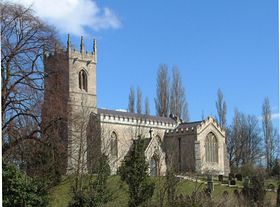Although it lies almost due east of Maltby, which is in South Yorkshire, the little village of Harworth is a part of Nottinghamshire–barely. It’s name comes from the Old English words har for gray (think hoary) and worth, meaning enclosure. The countryside used to be cultivated fields near the village, surrounded by the northern part of Sherwood Forest, but as in much of England, the forest has been destroyed, leaving open countryside and heath.
According to White Directory of Nottinghamshire, 1853 (found on genuki):
“Harworth is a pleasant village, with a small stream running through it, 2 miles east-south-east of Tickhill, and 3 miles west-south-west of Blyth. It contains 595 inhabitants and 1,428a 3r 2p of land, principally belonging to Lord Galway. The church, dedicated to All Saints, is an ancient fabric, built about the 12th century, except the chancel, which was erected in 1672. In repairing the building in 1828, an arched recess was discovered in the wall, with a cupboard containing a garland, a cribbage board, and several other articales of a more sacred character. At the same time a handsome cross was found in the churchyard, and is now placed above the east window.”
Unfortunately, in 1869, the church was extensively remodeled, and the only part of the old medieval church still standing is the tower, visible in the photo below. Â The changes destroyed any carvings that might have existed over the doorway. Of course, I have no idea if there really were any such carvings–poetic license strikes again–but you can see my inspiration in this depiction of the Seven Deadly Sins in an archway at Rosslyn Chapel (yes, the same Rosslyn Chapel that figured in The DaVinci Code).
If you look closely at the photo above, you can see the headstones standing just outside the chapel, much as they would have when Steinarr and Marian were searching for the next clue on their quest. At the time, though, there likely would have been a fence or wall around the church, similar to that in the illustration “English Country Churchyard” by Charlie Bedford found here.
Next up — Backtracking: Retford on Market Day
![]()


